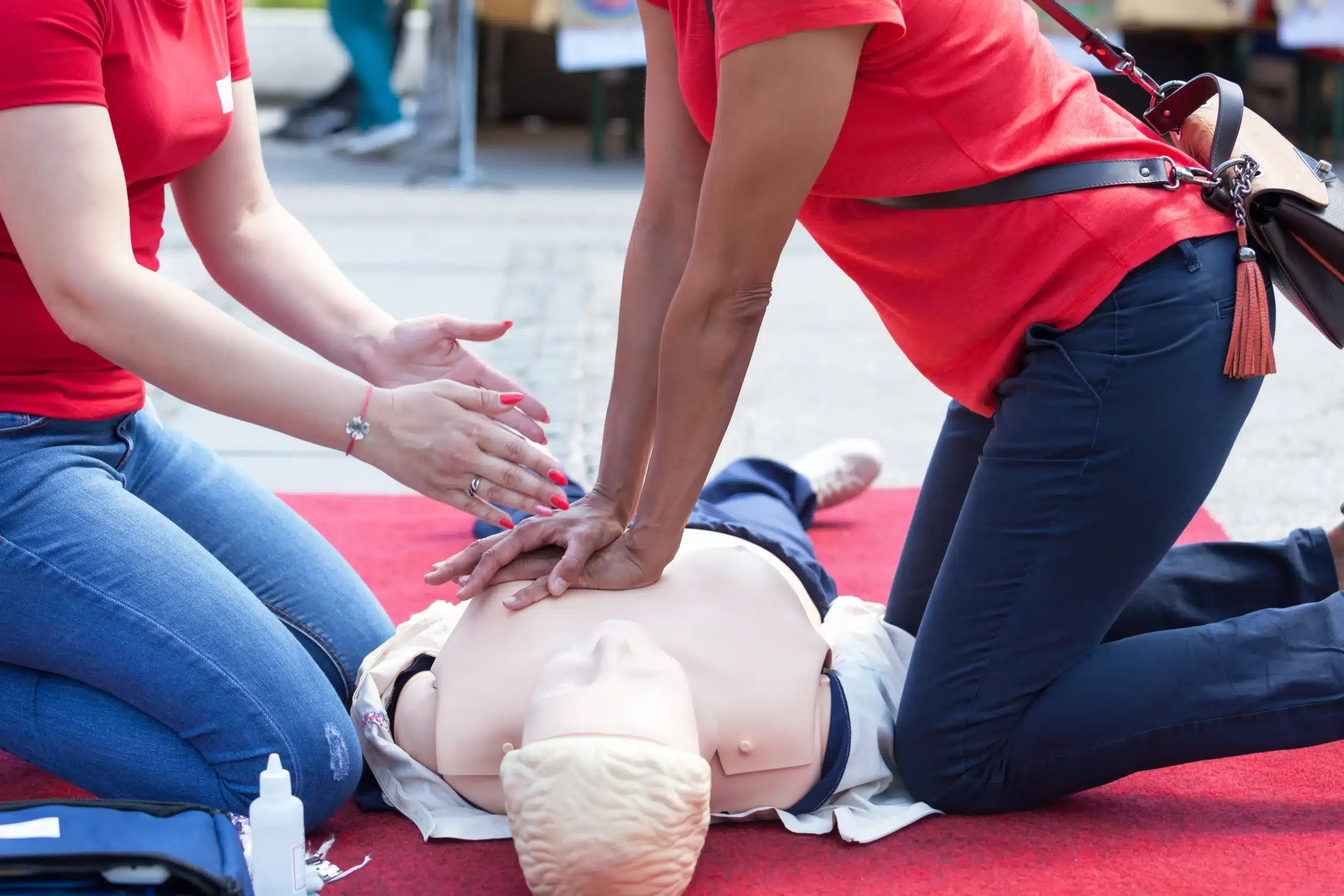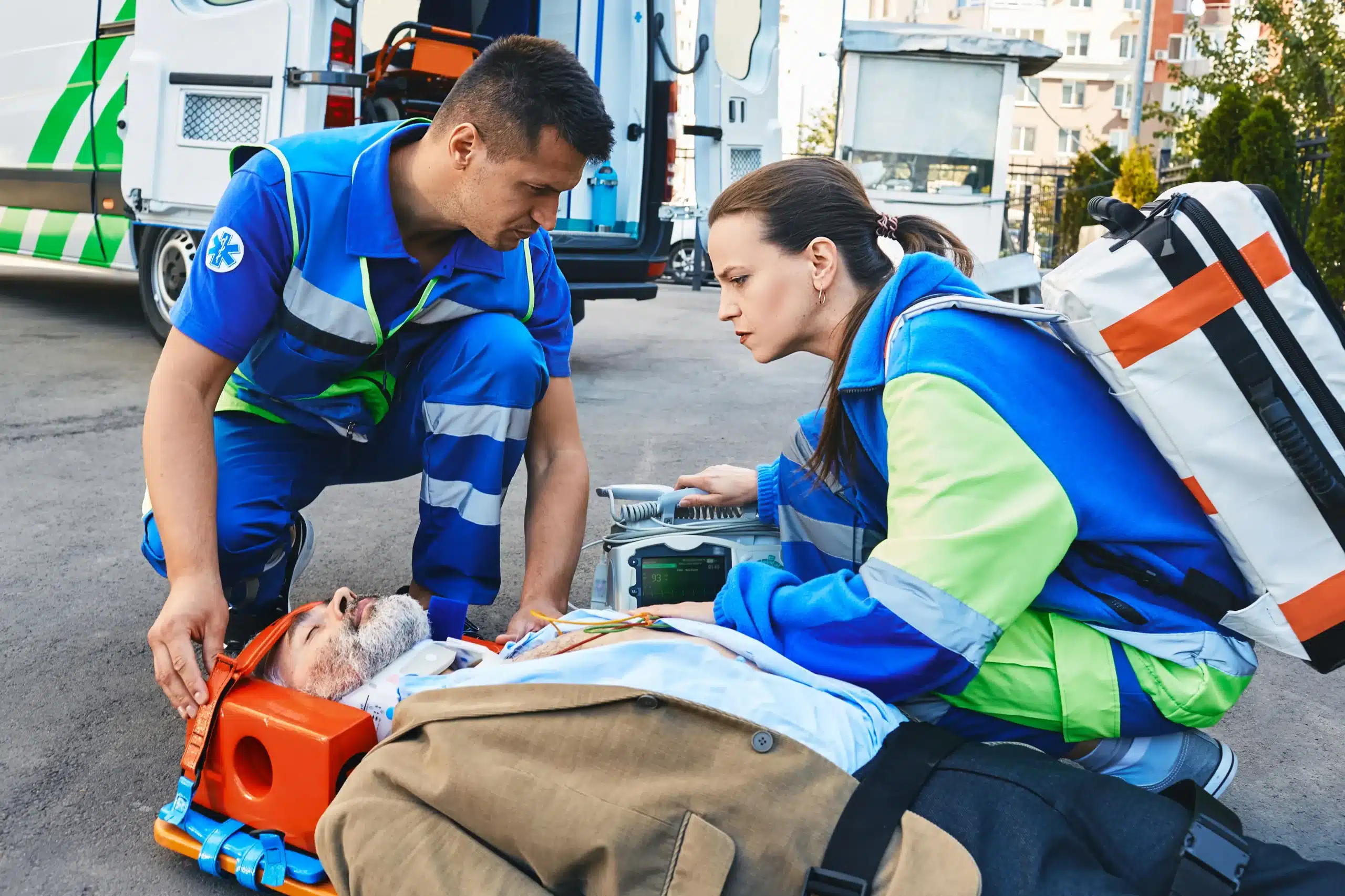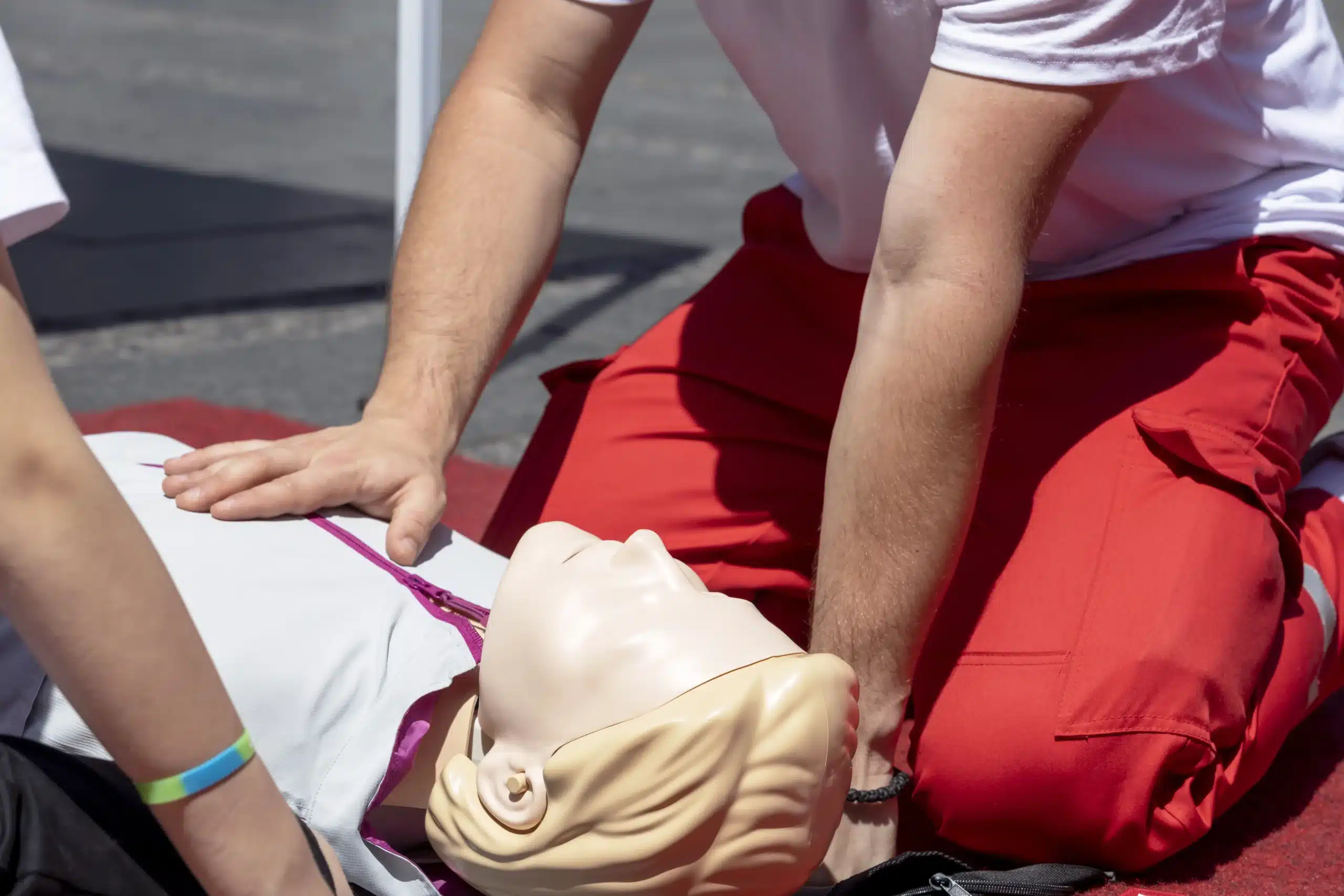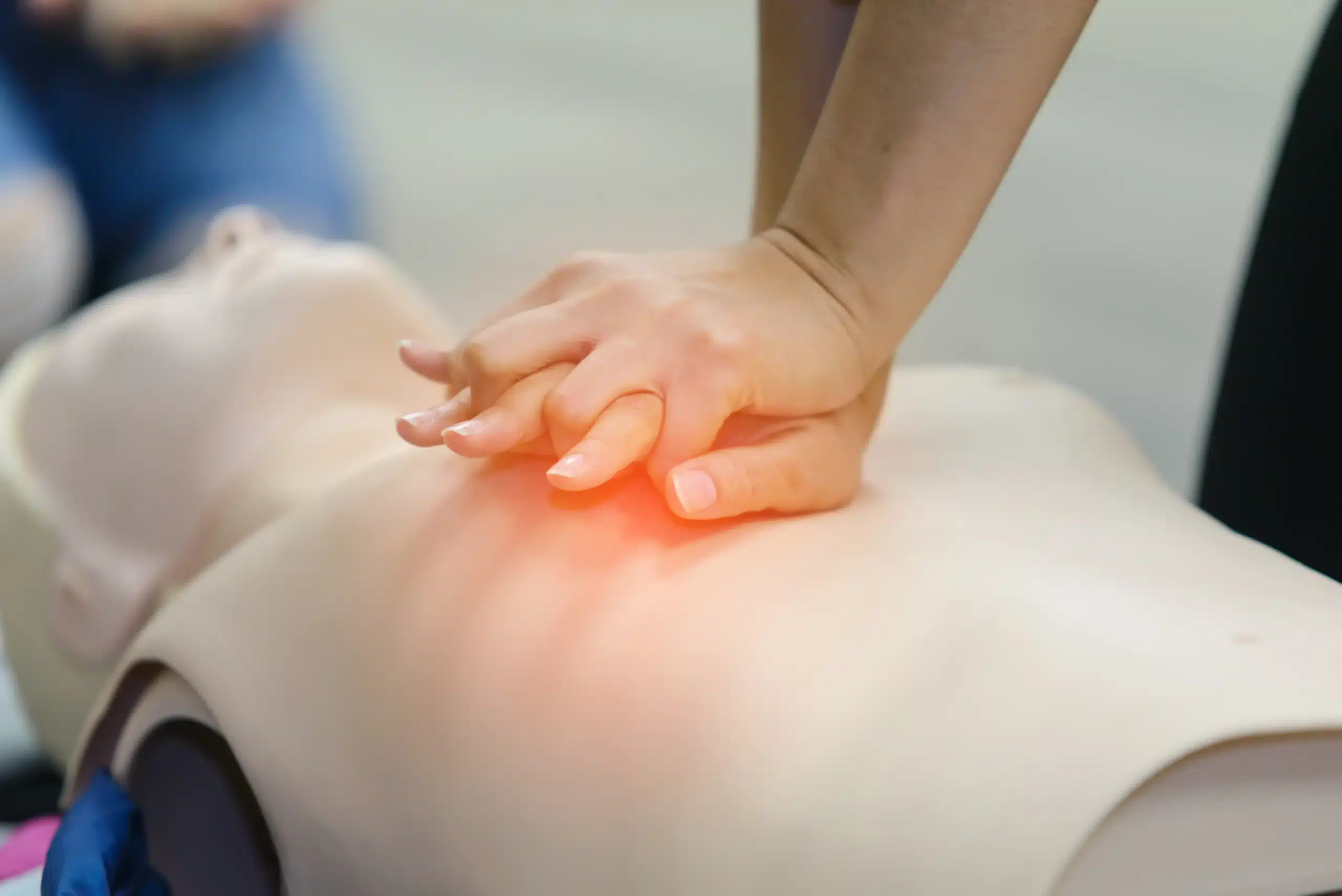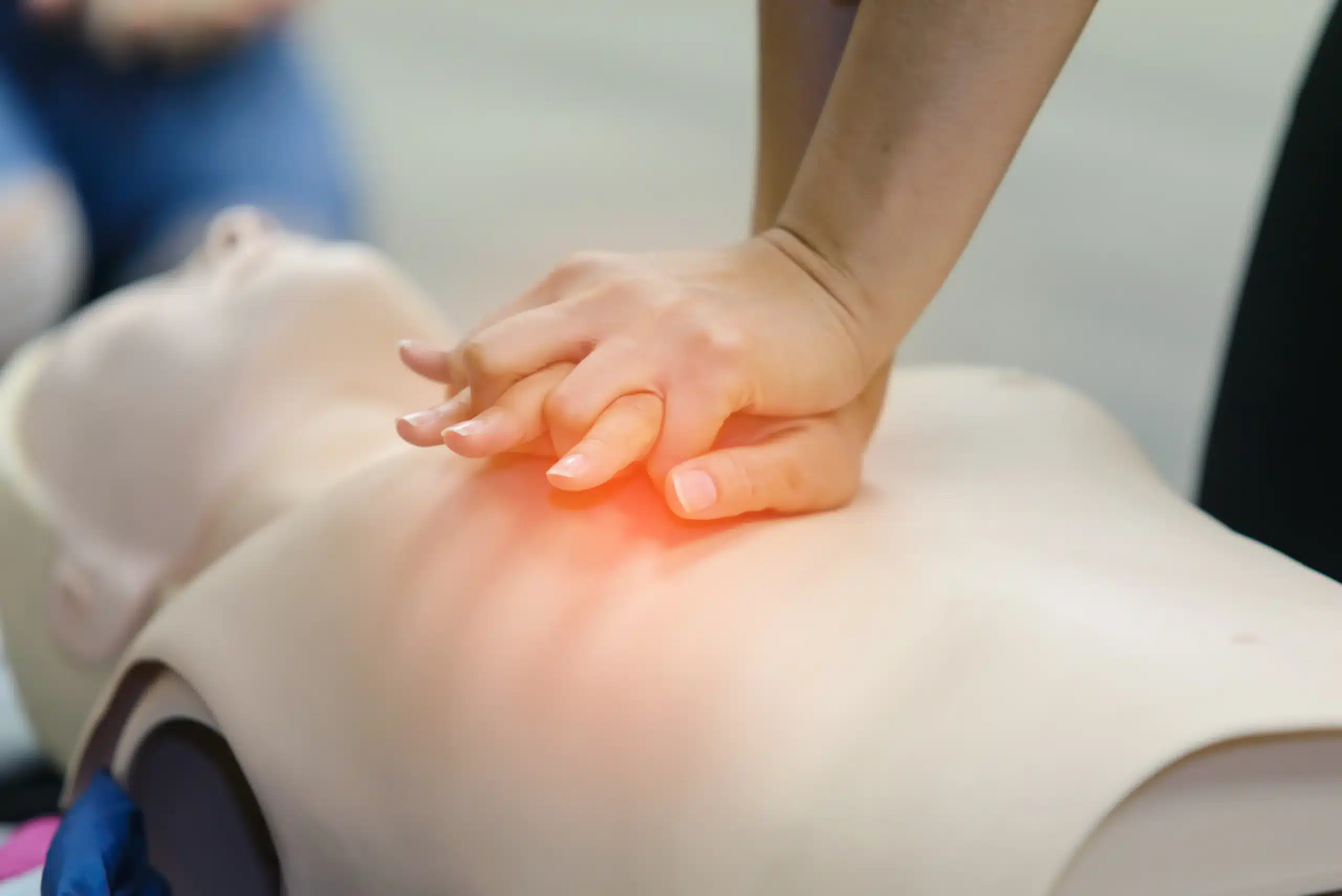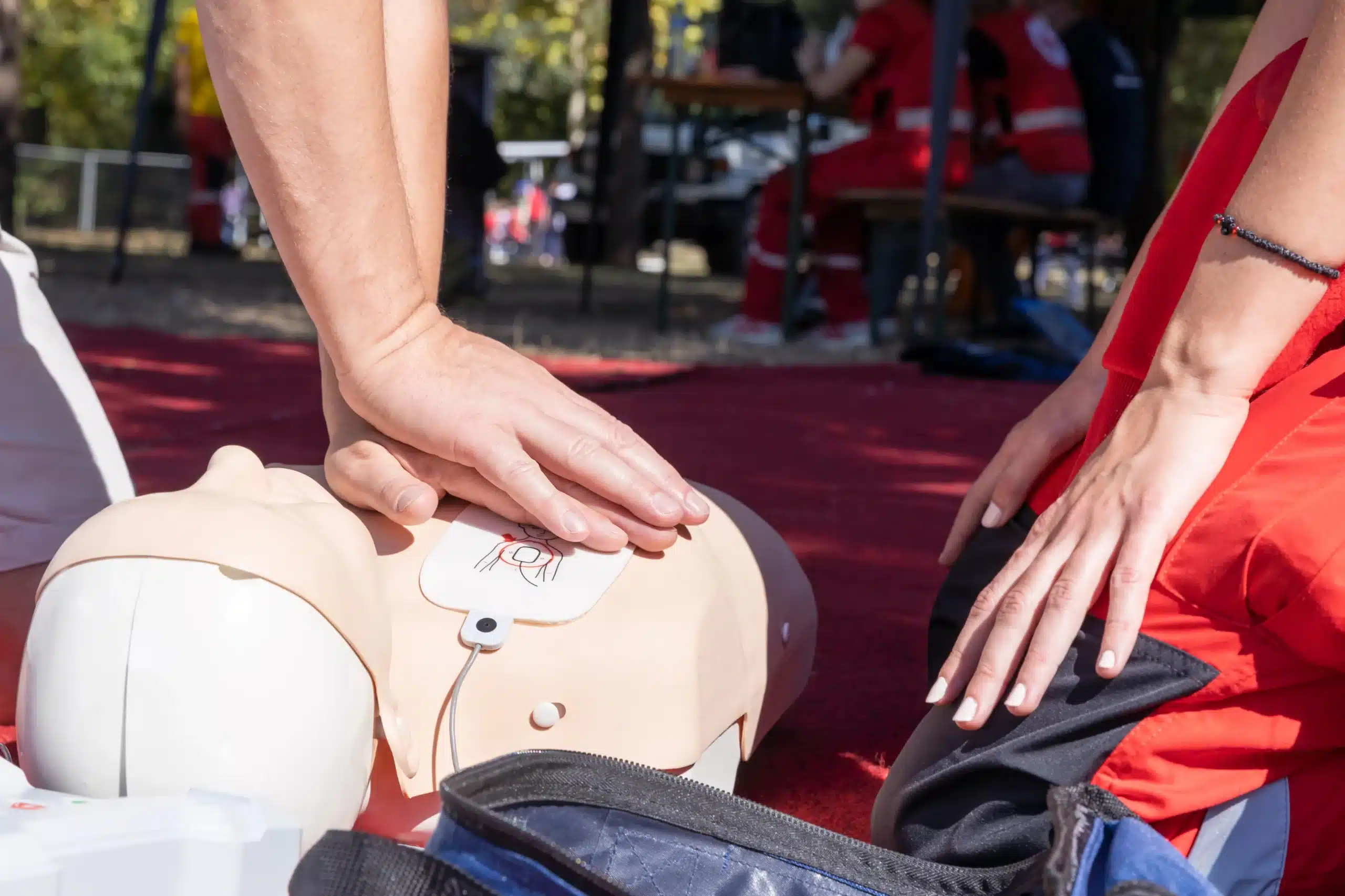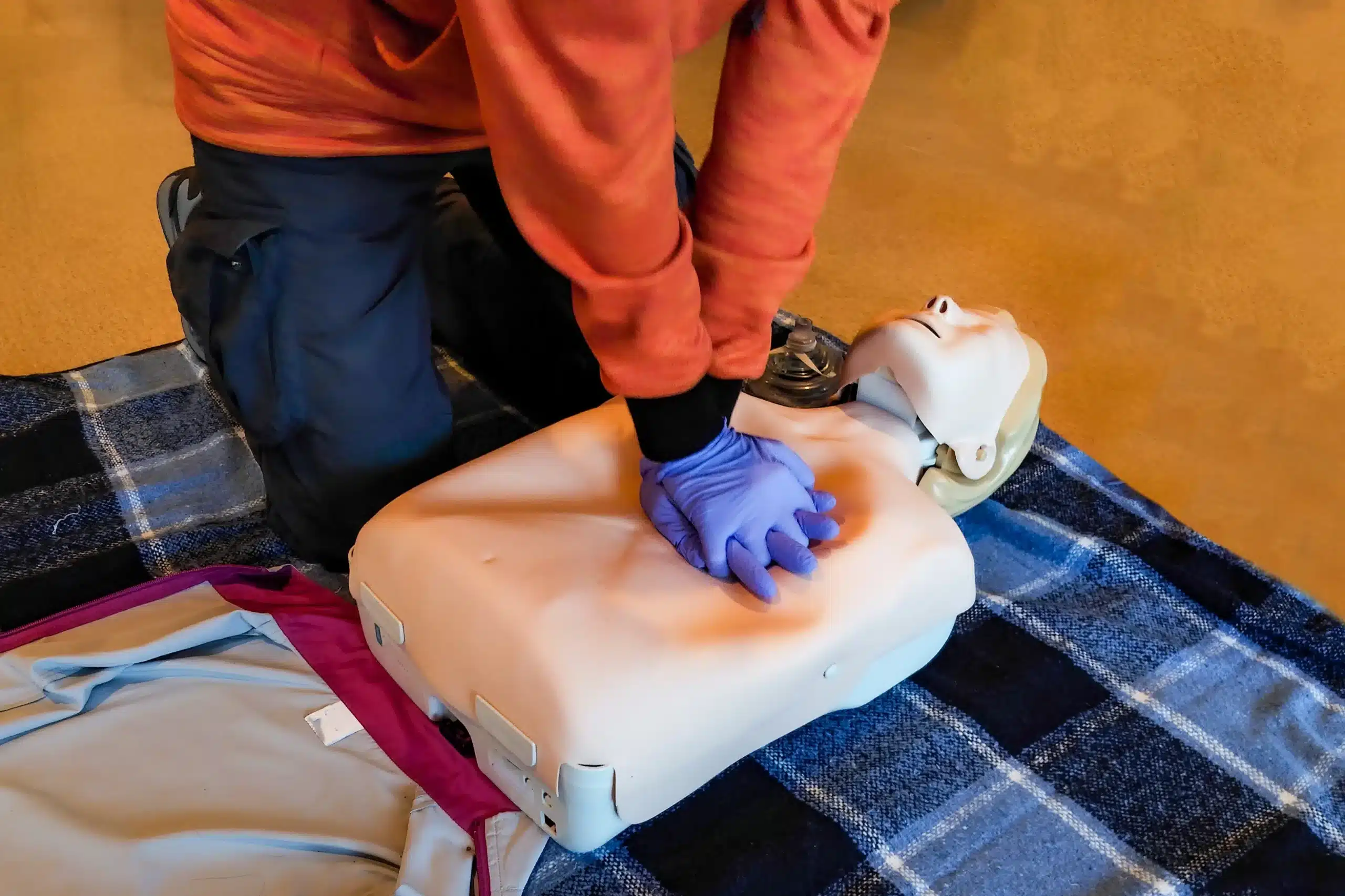In the heart of Silicon Valley, where innovation and technology thrive, there’s a growing need for a different kind of life-saving technology: the knowledge and skills of CPR and AED training in Palo Alto. This training isn’t just for medical professionals; it’s for everyone—parents, teachers, coaches, and anyone who wants to be prepared for an emergency. This guide will walk you through the essentials of CPR and AED training in Palo Alto, helping you understand the different courses, certification options, and the importance of hands-on practice. We’ll also address common misconceptions and provide you with the resources you need to find the right training program in Palo Alto.
Key Takeaways
- CPR and AED training are life skills: These skills empower you to confidently handle medical emergencies and potentially save lives, regardless of your profession. Seek out a course that blends online learning with hands-on practice for a well-rounded experience.
- Find the right course for you: AHA-accredited providers like Safety Training Seminars offer a range of courses, from basic to advanced certifications. Consider your individual needs when selecting a course. Explore options like group discounts to make training more affordable.
- Getting certified is easier than you think: The process is designed for convenience, with many providers offering blended learning and flexible schedules. Take the first step towards becoming a more prepared and confident community member.
What is CPR and AED?
This section covers the basics of CPR and AED and why they’re so important in emergencies.
What is CPR?
CPR stands for cardiopulmonary resuscitation. It’s a lifesaving technique used when someone’s breathing or heartbeat has stopped, like during a heart attack or near-drowning. CPR involves chest compressions and rescue breaths that manually pump blood and oxygen to the brain and other vital organs. Learning CPR empowers you to help in these critical situations until professional medical help arrives.
How do AEDs Work?
AED stands for automated external defibrillator. It’s a portable electronic device that analyzes the heart’s rhythm and, if needed, delivers an electric shock to restore a normal heartbeat. Modern AEDs are user-friendly, with clear audio and visual instructions to guide even those without medical training. Knowing how to use an AED can significantly increase the chances of survival for someone experiencing sudden cardiac arrest.
Why Combine CPR and AED Skills?
CPR and AED skills work together to maximize the chances of survival during a cardiac emergency. CPR maintains blood flow and oxygen, buying time until an AED can restore a normal heart rhythm. Studies show that combining CPR and AED dramatically improves survival rates compared to using either technique alone. Learning both CPR and AED equips you with the skills to respond effectively in various emergencies.
CPR and AED Courses in Palo Alto
CPR and AED training are crucial for responding to medical emergencies. Different courses cater to various skill levels and professional needs. Here’s a breakdown of the courses available in Palo Alto:
Basic Life Support (BLS)
BLS certification provides the foundational skills needed to respond to life-threatening emergencies. You’ll learn how to perform CPR, use an AED, and relieve choking for adults, children, and infants. High-quality BLS training emphasizes hands-on practice and covers teamwork and high-performance CPR. Our BLS certification course provides comprehensive training.
Advanced Cardiovascular Life Support (ACLS)
ACLS courses are designed for healthcare professionals who manage cardiopulmonary arrest and other cardiovascular emergencies. This advanced training covers recognizing and managing life-threatening cardiac events, advanced airway management, and emergency pharmacology. It also emphasizes effective team dynamics and communication during resuscitation efforts. Learn more about our ACLS course.
Pediatric Advanced Life Support (PALS)
PALS certification focuses on the specialized skills needed to respond to emergencies involving infants and children. The course covers pediatric assessment, airway management, and effective resuscitation techniques. PALS training also addresses the physiological differences between children and adults, ensuring you’re prepared to provide appropriate care. Our PALS training offers comprehensive instruction.
First Aid and CPR/AED Combo Courses
Combining CPR/AED training with first aid skills creates a well-rounded approach to emergency preparedness. These combo courses teach you how to respond to various medical situations, from cardiac arrest to common injuries like burns and cuts. You’ll gain essential skills such as bleeding control, wound care, and recognizing the signs of a stroke. Our CPR and First Aid classes cover a range of first aid topics.
Find the Right Training in Palo Alto
Choosing the right CPR and AED training is crucial for effective emergency response. Here’s what to consider when selecting a course in Palo Alto:
Accreditation and Reputation
Look for training providers accredited by nationally recognized organizations like the American Heart Association (AHA). AHA-certified courses ensure your training aligns with the latest CPR and ECC guidelines. Safety Training Seminars, for example, is a woman-owned AHA Training Center offering a range of AHA courses, including CPR, First Aid, BLS, ACLS, and PALS. A strong reputation within the community also speaks volumes about a provider’s commitment to quality.
Instructor Qualifications
Experienced, certified instructors make all the difference. Instructors should hold current certifications and demonstrate a passion for teaching and clear communication. Find a course that emphasizes hands-on practice and provides opportunities to ask questions and receive personalized feedback. This ensures you gain the confidence and skills to perform CPR effectively in a real-life emergency.
Customer Feedback and Reviews
Reading reviews from past students offers valuable insights into the training experience. Look for comments about the instructor’s teaching style, the course content, and the overall learning environment. Positive feedback about hands-on practice, constructive feedback, and real-life scenario simulations can help you identify a high-quality training provider.
Top Palo Alto Training Providers
Several reputable organizations offer CPR and AED training in Palo Alto:
Safety Training Seminars
Safety Training Seminars offers a comprehensive range of AHA-certified courses, including BLS, ACLS, PALS, and First Aid. They provide convenient daily classes, making it easy to fit training into your schedule. Their commitment to small class sizes ensures personalized attention from instructors.
Stanford Health Care
Stanford Health Care also provides various CPR and first-aid courses, including BLS, ACLS, and PALS certification classes. Their affiliation with a renowned medical institution suggests a commitment to high-quality medical training. You can typically find their course schedule on their website.
Palo Alto Medical Foundation
Palo Alto Medical Foundation offers specialized courses like the Pediatric First Aid AED CPR class, which meets California’s licensing requirements for daycare and preschool teachers. This makes them a good option for those working in childcare settings. Check with the foundation directly or search online for their current course offerings.
American Red Cross
The American Red Cross is a well-known provider of CPR/AED certification courses. Their widespread presence and established reputation make them a reliable choice for individuals seeking nationally recognized certification. You can easily locate courses and register online through their website.
Course Details and Logistics
This section covers the practical details of CPR and AED training in Palo Alto, from class schedules and locations to course content and hands-on practice. Knowing these details will help you choose the right course and prepare for a smooth training experience.
Class Locations and Schedules
CPR and AED classes are conveniently offered daily at 467 Hamilton Avenue, Ste. #5, Palo Alto, CA 94301. Office hours are 8 am to 10 pm, providing flexibility for those with busy schedules. Safety Training Seminars offers classes in over 60 cities, and if you have a group, you can arrange for a class at your location. This makes it easy to find a class that fits your schedule and location preferences.
Online vs. In-Person Training
Many CPR and AED courses now offer a blended learning approach. This typically involves completing the cognitive portion of the course online at your own pace, followed by an in-person skills test. This online learning option uses RQI software, a program designed for convenient and effective learning. For BLS, ACLS, and PALS certifications, a faster option is available that combines online learning with a skills test using a voice-assisted manikin. This modern approach streamlines the certification process while still ensuring competency.
Course Structure and Content
Courses cover a range of certifications, from basic Heartsaver classes to advanced life support. You can find training in Basic Life Support (BLS) for healthcare providers, Pediatric First Aid with CPR/AED, and more specialized certifications like ACLS and PALS. Detailed course descriptions are available to help you choose the right training for your needs. Knowing what each course covers will help you meet your specific certification requirements.
Hands-on Practice and Scenarios
The in-person skills test is a crucial part of CPR and AED certification. You’ll practice your skills on a computerized manikin, giving you realistic training experience. While an instructor may not always be physically present during the test, support is available by phone if needed. This hands-on practice reinforces the importance of immediate CPR in emergencies. CPR helps maintain vital blood flow and oxygenation until an AED can be used, maximizing the chances of survival. This practical experience builds confidence and prepares you to respond effectively in real-life situations.
Certification and Costs
Getting certified in CPR and other life-saving skills often involves a few key considerations: the certifying organization, the learning format, and of course, the cost. Let’s break down these aspects to help you make informed decisions about your training.
American Heart Association Certification
The American Heart Association (AHA) is a widely recognized and respected organization offering various certification courses in CPR, First Aid, BLS (Basic Life Support), ACLS (Advanced Cardiovascular Life Support), and PALS (Pediatric Advanced Life Support). These certifications are highly valued and often required for many healthcare professionals. AHA certification ensures you’re receiving high-quality training based on the latest scientific guidelines. For those outside the healthcare field, an AHA certification demonstrates a commitment to providing effective assistance during medical emergencies.
RQI Program
If you’re looking for a flexible and efficient way to get certified, the RQI (Resuscitation Quality Improvement) program might be a good fit. RQI offers a blended learning approach combining online coursework with hands-on skills testing. This allows you to learn at your own pace and demonstrate your skills using a voice-assisted mannequin. RQI certification is available for BLS, ACLS, and PALS, a convenient option for busy professionals needing to maintain their certifications.
Course Pricing
Understanding course pricing is essential for budgeting your training. At Safety Training Seminars, our comprehensive BLS CPR Provider Heartcode course, including the online portion and the in-person skills evaluation, is priced at $120. This combined approach offers both convenience and the necessary hands-on practice. You can find more information about our low price guarantee on our website. We believe that cost shouldn’t prevent anyone from acquiring these essential life-saving skills.
Group Discounts and Promotions
We offer group discounts for businesses, organizations, or groups of friends and family who want to train together. This can be a cost-effective way to ensure everyone in your team or community is prepared to respond to emergencies. Contact us to learn more about customizing a training program to meet your group’s specific needs and budget. We offer daily classes, making it easier to find a time that works for everyone.
Who Needs CPR and AED Training?
CPR and AED training gives people the skills to respond effectively during medical emergencies. While helpful for everyone, some professions and community members especially benefit from this life-saving knowledge. Let’s explore who needs CPR and AED training:
Healthcare Professionals
Healthcare professionals, including nurses, medical assistants, dental professionals, and physical and occupational therapists, are often the first on the scene in medical emergencies. CPR certification is crucial for these individuals, ensuring they can administer CPR effectively and potentially save lives. For those in healthcare, advanced certifications like ACLS (Advanced Cardiovascular Life Support) or PALS (Pediatric Advanced Life Support) can further enhance their expertise in specific emergency situations.
Parents and Childcare Providers
For parents, nannies, and childcare providers, CPR and AED training focused on pediatric care is invaluable. Knowing how to respond to emergencies involving children can be life-changing. Pediatric First Aid, CPR, and AED classes often meet licensing requirements for daycare and preschool teachers in California, ensuring they’re prepared to handle emergencies involving children under their care. Check with your local licensing board for specific requirements. Safety Training Seminars offers courses designed for parents and caregivers.
Teachers and Education Staff
Teachers and education staff are responsible for student safety throughout the school day. CPR and AED training empowers them to respond to emergencies in the classroom, playground, or during school events. Comprehensive training, including First Aid, CPR, and AED certification, provides these essential, life-saving skills. Many organizations offer blended learning options, combining online learning with in-person skills practice.
Workplace Safety Personnel
Workplace safety personnel play a crucial role in maintaining a safe work environment. BLS certification ensures they receive quality training from certified providers, equipping them to handle medical emergencies effectively. This training is vital for various workplaces, from construction sites to corporate offices, and demonstrates a commitment to employee safety. Consider exploring group discounts for workplace safety training to make it more accessible for your entire team.
Prepare for Your CPR and AED Course
Getting ready for your CPR and AED course doesn’t require a ton of prep, but a little planning goes a long way. Here’s what you should know to feel confident and prepared on the day of your training.
What to Bring
Keep it simple. Bring a valid photo ID so the instructor can verify your identity for your certification card. Your training provider, like Safety Training Seminars, will let you know if there are any specific materials required. Everything you need is usually provided during the course itself.
Pre-Course Materials
Some CPR and AED courses include online learning modules. If your course has an online component, set aside some time to complete it before your in-person skills session. This online portion often covers the background information and theory, allowing you to focus on hands-on practice during the in-person training. Check with your chosen provider to see if your course has this element. For example, RQI courses through Safety Training Seminars utilize this blended learning approach.
Physical Requirements and Considerations
CPR training involves physical activity, including performing chest compressions and practicing rescue breaths. While you don’t need to be an athlete, it’s good to be aware of the physical aspects. If you have any physical limitations or concerns, discuss them with your instructor or training provider beforehand. They can offer modifications or suggestions to help you fully participate. Remember, starting CPR quickly is crucial in a real emergency, so the training aims to prepare you to respond effectively.
The Impact of CPR and AED Training in Palo Alto
Learning CPR and how to use an AED has a ripple effect, impacting not only your own life but also the entire Palo Alto community. From increasing survival rates during cardiac emergencies to fostering a greater sense of preparedness, the benefits of these skills are significant.
Improve Survival Rates
CPR and AED training equips you with the tools to respond effectively during a cardiac arrest. Administering CPR while waiting for first responders can dramatically improve survival rates. When combined with the use of an AED, the chances of survival increase even further. These two techniques work together to bridge the gap between the onset of cardiac arrest and the arrival of professional medical help. CPR helps maintain blood flow to vital organs, while an AED can restore a normal heart rhythm. Learn more about how these life-saving techniques complement each other at CPR Care.
Build Confidence in Emergencies
Beyond the technical skills, CPR and AED training instills confidence and empowers you to act in high-pressure situations. Knowing you have the skills to potentially save a life can make all the difference. Effective training programs, like those offered by Safety Training Seminars, focus on building practical skills through hands-on practice and realistic scenarios. This approach helps students develop the confidence to respond effectively in real-life emergencies. Constructive feedback and student-centered learning further enhance the training experience, as highlighted in this article on CPR instruction.
Create a Safer Community
When more people in a community are trained in CPR and AED use, it creates a network of potential lifesavers. This can significantly impact the overall safety and well-being of the community, especially in Palo Alto, where a quick response can be critical. The Palo Alto Fire Department actively encourages residents to learn CPR. Safety Training Seminars also contributes to this effort by offering a variety of AHA-certified courses, including BLS, ACLS, PALS, and First Aid, making these essential skills accessible to more people.
CPR and AED Training Misconceptions
It’s easy to put off CPR and AED training. Maybe you think it’s unnecessary or too complicated. Let’s debunk some common misconceptions and show you why learning these skills is easier and more important than you might realize.
“It’s Only for Healthcare Professionals”
Many assume CPR certification is just for doctors and nurses. Not true! While essential for healthcare providers, CPR and AED training benefits everyone. Think about teachers, childcare providers, coaches, parents—anyone who interacts with the public or cares for others. Even if you don’t work in healthcare, knowing CPR can make you a valuable asset in an emergency. In fact, the Pediatric First Aid AED CPR class taught in Palo Alto is a required certification course for licensed daycare and preschool teachers in California.
“CPR is Too Complicated”
Worried about memorizing complex steps? Modern CPR training focuses on straightforward techniques anyone can learn. It emphasizes chest compressions and rescue breaths, providing temporary support until professional help arrives. Combining CPR with AED skills further simplifies the process. The AED analyzes the heart rhythm and delivers a shock if needed, while you continue CPR. It’s a team effort, and the training provides clear guidance every step of the way. Our classes at Safety Training Seminars emphasize hands-on practice so you build confidence.
“AEDs are Dangerous or Difficult”
AEDs are designed with user-friendliness in mind. They have clear voice instructions and visual prompts that guide you through each step. Modern AEDs are incredibly safe and won’t deliver a shock unless it’s necessary. The fear of doing something wrong shouldn’t hold you back—the AED itself helps prevent errors. Our instructors at Safety Training Seminars will show you just how easy it is to use an AED.
“Bystander CPR is Ineffective”
This is perhaps the most dangerous misconception. Immediate CPR by a bystander can double or even triple a person’s chances of survival during cardiac arrest. Studies show that bystander CPR, combined with the use of an AED, significantly increases survival rates. Every second counts, and your actions can make all the difference while waiting for paramedics. Don’t underestimate the power of your intervention—it can truly save a life. Take a CPR and AED course with Safety Training Seminars and empower yourself to make a difference.
Related Articles
- Find CPR Courses Near Me: Your Guide to Getting Certified – Palo Alto CPR Classes
- Why CPR is Crucial in Healthcare
- CPR Certification in Palo Alto: Your Guide – Palo Alto CPR Classes
- Free CPR Training: Your Guide to Life-Saving Skills – Palo Alto CPR Classes
- Top 11 CPR Myths Debunked
Frequently Asked Questions
What’s the difference between BLS, ACLS, and PALS?
BLS (Basic Life Support) teaches essential CPR and AED skills for anyone, including healthcare providers and the general public. ACLS (Advanced Cardiovascular Life Support) is designed for healthcare professionals managing cardiac arrest and other cardiovascular emergencies. It goes beyond basic CPR, covering advanced airway management and pharmacology. PALS (Pediatric Advanced Life Support) focuses on the specific needs of infants and children during emergencies.
How do I choose the right CPR/AED course for me?
Consider your current skills and needs. If you’re new to CPR, a BLS course is a great starting point. Healthcare providers often require BLS, ACLS, or PALS depending on their role. If you work with children, PALS or a pediatric-focused first aid/CPR/AED course is recommended. Look for courses accredited by reputable organizations like the American Heart Association and taught by experienced, certified instructors.
What if I have physical limitations? Can I still learn CPR?
Absolutely! Talk to your instructor or training provider about any physical limitations you have. They can offer modifications or suggestions to help you participate fully. The goal is to equip you with the knowledge and skills to assist in an emergency to the best of your ability.
Are online CPR/AED certifications valid?
Many organizations now offer blended learning, combining online coursework with in-person skills testing. This allows for flexible learning while still ensuring you demonstrate practical competency. Check with your employer or licensing board to confirm they accept blended learning certifications. The RQI program, for example, offers this approach for BLS, ACLS, and PALS.
How much does CPR/AED training cost, and are discounts available?
Costs vary depending on the course type and provider. Check with specific training centers like Safety Training Seminars for their pricing. Many providers offer group discounts for businesses, organizations, or families learning together. Some also have low-price guarantees, ensuring affordable access to these vital skills.
